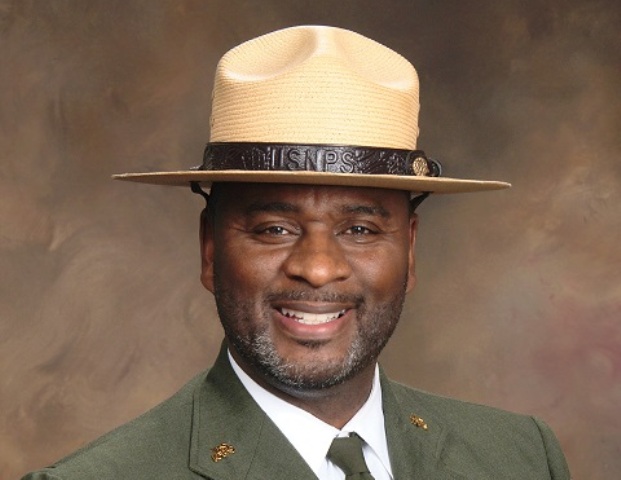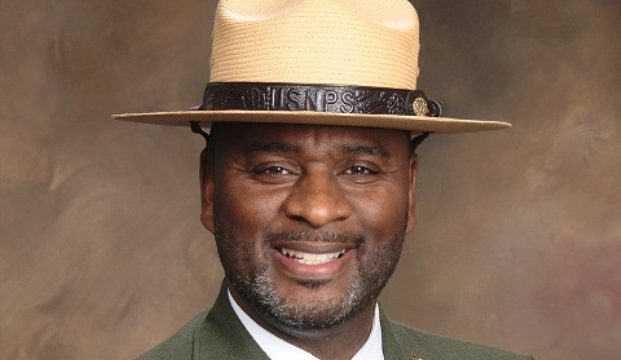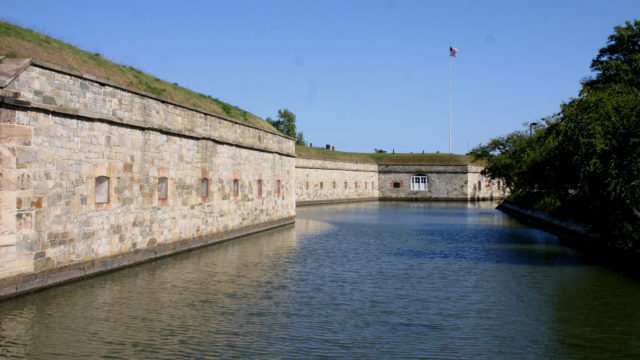By Michael Curry
Let me introduce you to Fort Monroe National Monument Superintendent Terry Brown.
He is one of those visionaries with a gleaming smile and commanding presence because he loves what he does and lives what he does with a passion.
A National Park Service employee for more than 27 years, Terry was appointed Superintendent of the Fort Monroe National Monument in 2016. “I still cannot believe that I actually get paid for doing what I love” he says with conviction.
After just over a year of coming to basically establish the Fort as part of the National Park Service, he has already made huge strides and is relishing his role as a leader in the integration of the historic Fort into not only the complexities of the federal, state and local systems but, perhaps, more importantly into the hearts and minds of visitors to the Fort which is finally gaining appropriate recognition for its historical, architectural and cultural significance to the Nation.
James R. Joseph a member of Fort Monroe’s Board of Trustees says” Terry has already had a wonderful impact and has established a real presence for the National Park Service here at Fort Monroe. He enthusiastically embraces all of the challenges inherent in the process of integrating the Fort into the National Park Service. We are told that this complicated procedure can take up to ten years but we as a Board are confident that Superintendent Terry will achieve these goals in much less time than that”.
A major milestone will be the opening of the Visitor Center in 2019. A joint venture between the Authority and the Park Service, the $8 million project will realize and bring to life the entire experience for visitors from all across the country and establish something very close to Terry Brown’s heart – a memorable and educational adventure into more than four centuries of rich history.
“In all my years of service, I have never worked in a place where the partnerships between the National Park Service and the community are so strong. It was so obvious to me when I first arrived here that the entire community is really jazzed up about the future of the Fort and really excited about bringing it back to life as a destination.”
Before coming to head the somewhat daunting tasks of working with a myriad of institutions, boards and other players here at Fort Monroe,, Terry served in various supervisory capacities in the greater Boston area National Park Service for more than 15 years. He was widely acclaimed for his tenure as Chief of Visitor Services, Chief of Interpretation and Education and as a Site Manager., His prior assignments also included a two year stint as Supervisory Park Ranger at the National Mall and Memorial Parks in Washington, D.C.
Superintendent Terry remembers with much fondness his first exposure to the National Park Service.
Having grown up as a military “brat” in Germany and Holland, he enrolled as a student in the Criminal Justice Program at Grambling State University in Louisiana. He had always wanted to be a Marine as he grew up but his life changed when a National Park Service representative came to give a talk to the 70 or 80 students in Terry’s business class. He recalls that when the Park Service Ranger asked for questions there were no responses from the audience. But, he then met her out in the corridor and chatted about the possibilities for his future.
She signed him on the spot and, as he says with great joy: “I jumped in my Plymouth Horizon and drove from Louisiana to Pennsylvania. I could not believe that I was going to be paid to live in the natural world,. flipping burgers and absorbing the history and amazing beauty of the park.”
Hooked ever since, Superintendent Terry now heads the latest addition to the 22 national parks in the Commonwealth of Virginia. Combined these parks attract more than 25 million visitors each year and have an economic impact of more than $1 billion!. The National Park Service, established by President Woodrow Wilson in 1916 now encompasses more than 400 sites including The White House, parks and monuments, battlefields and, most recently, Fort Monroe. President Barack Obama declared it a National Monument in 2011, recognizing and immortalizing its more than 400 year history.
Relishing the prospects of putting Fort Monroe on the National Park’s map, Superintendent Terry says: “All I want to be is a positive force and a positive role model.”
Well that is already happening.
Within just a few months of arriving at the Fort, Terry helped to initiate the restoration of what some would call the most important building on Fort Monroe, insisting that a sign be placed prominently to let visitors know that something is happening and work is progressing.
In addition to supervising the more than 327 acres (out of the total 565 which make up the Fort), Terry Brown is also directly responsible for the preservation and upkeep of some of the most important buildings at Fort Monroe. These include Quarters No 1 built in 1819, Lee’s Quarters built in 1823 and Building No. 50 which was built as Officer’s Quarters in 1834.
Lee’s Quarters, also named The Tuileries, housed 8 bachelor officers originally. Robert E. Lee lived here (hence the name) from 1831 to 1834 as he supervised construction of the Fort which had been designed by the noted French General Simone Bernard who had served under Napoleon. Lee’s Quarters are now the headquarters of the National Park Service here and house the Superintendent’s office as well as private residences.
“Fort Monroe is totally unique,” explains the Superintendent. “It embodies more than 400 years of history which is truly amazing. Some of the historical facts can be a little disconcerting, but things happened here which changed the course of the Nation’s history, especially the Contraband stories
These will all be a significant part of the visitor’s experience as the Park becomes fully integrated in the National system. As Terry also points out, Fort Monroe is unique as a park on account of the partnerships between the Fort Monroe Authority (which is basically in charge of the real estate) and the fact that there are established business in the Park including the Paradise Ocean Club, the RV Park and Deadrise restaurant as well as Oozlefinch Brewery.
QUARTERS NO.1 The DeRussy House
Originally built as Officer’s Quarters in 1819, this is the oldest building on the Fort boasting many significant architectural and historical details. The structure sits right at the East Gate entrance just inside the moat and has an imposing stone staircase leading to the front entrance as well as wrought iron railings and sawn balustrades. The interior which the public will soon be able to enjoy features vaulted ceilings, a dome above the elliptical staircase and several mantles in marble and wood. The second floor has alternating light and dark floorboards in the highly unusual solarium.
Quarters No. 1 was home to the Fort’s engineers during construction and later hosted many politicians and statesmen including the Marquis de Lafayette who stayed here in 1824. Then in 1861, General Benjamin Butler occupied the quarters where he made the world changing “Contraband Decision”. Just a year later, President Abraham Lincoln stayed here as he and his advisors planned the Union attack on Norfolk.
The comprehensive, multi phase restoration project is being managed by the Historic Architecture and Engineering Center (HACE) of the National Park Service with careful guidance and hands on participation by Superintendent Brown of course. While exterior renovations are in progress, Superintendent Brown is overseeing an in depth study of the structural elements of the building which, when finished, will determine the use and public access to the structure. As Terry says, the Park Service’s standards for this kind of work are exacting not just for historical reasons but more importantly for safety.
BUILDING NO 50.
Another of Superintendent Terry’s early accomplishments is the establishment of the HOPE program on the Fort. A National Trust initiative, this program – Hands on Preservation Experience – employs young adults between the ages of 18 and 25 to help preserve and restore historic structures.
Terry personally recruited the first team of six youngsters this year from such institutions as Hampton University, Hampton High School, Christopher Newport University and Norfolk State University. The HOPE crew has been working all summer on Building No. 50, replacing the first and second floor porches among other things. The program trains these young people to look for architectural details and preserve them so that the history continues for future generations.
Building No. 50, built in 1834 is actually a set of three interconnected buildings all joined by a long hall which was added in 1887 or thereabouts.
According to Glenn Oder, Executive Director of the Fort Monroe Authority, this HOPE program allows the public to watch the restoration work in progress and this will hopefully be the first of many such projects on the Fort.
OTHER VISIONS FOR THE FUTURE
Constantly thinking of new ways to enhance the visitors experience and to engage them in the history, Terry Brown says with a laugh that he sometimes just has to sit back and breathe because his vision sometimes outpaces the product while he is always aware of the ways in which people are using the park. “I want people to ask questions”, he says, “and I want my park rangers to provoke thought”.
He has already instituted walking tours and has ordered complete new signage from the National Park Service which will further identify the property as a National Monument. His office will also be installing new park benches and ecologically friendly trash cans (the solar powered kind that actually compact the refuse) and has many other projects on the back burner such as candlelight walking tours, new and expanded walking trails, etc. etc.
“All I want to be is a positive force,” he exclaims. “I want to be a positive role model, especially for young people as we work to get them engaged in the remarkable history and architecture of this national treasure.”
For more info: www.nps.gov/fomr
Michael Curry founded and directed Hampton Arts (The American Theatre and The Charles H. Taylor Arts Center) for 25 years. Now a freelance writer, he published his first book, Dining Among the Stars, in 2016. www.mpcarts.com






